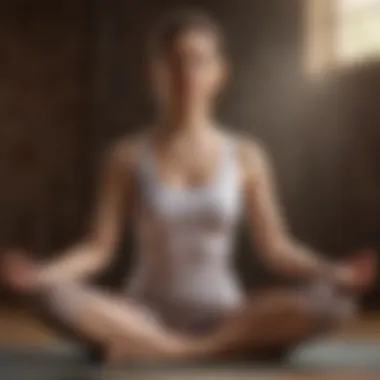Unlock Time and Harmony with a Beginner's Daily Yoga Routine for Wellness


Time Management Techniques
As you embark on your journey to reclaim your time and harmonize your life through a daily beginner yoga routine, it's essential to integrate effective time management techniques. Prioritization methods will guide you in identifying key tasks that align with your goals and values. Task scheduling strategies can help you allocate dedicated time for yoga practice amidst your busy schedule. To prevent procrastination, incorporating time blocks specifically for yoga can ensure consistent practice and enhance your overall well-being.
Personal Development Insights
Incorporating personal development insights into your daily beginner yoga routine can have a transformative impact on your well-being and life harmony. Setting and achieving goals related to your yoga practice can instill a sense of accomplishment and progress. By embracing mindfulness practices during yoga, you can cultivate moment-to-moment awareness and improve focus. Engaging in self-reflection exercises post-yoga sessions can deepen your understanding of yourself and enhance personal growth.
Work-Life Balance Solutions
Achieving work-life balance is paramount in optimizing your overall well-being. Setting boundaries in your professional life, such as designating specific yoga practice times, can help in separating work from personal time. Incorporating stress management techniques into your routine, like deep breathing exercises during yoga, can reduce stress levels and promote relaxation. Cultivating healthy habits that promote work-life integration, such as mindful eating and regular movement breaks, can enhance your overall balance and productivity.
Productivity Tools and Resources
Enhance your productivity journey by leveraging various tools and resources in your daily routine. Time tracking apps and software can assist in monitoring your time allocation for yoga practice alongside other activities. Task automation tools like calendar reminders for yoga sessions can streamline your daily schedule and ensure consistent practice. Implement efficiency-boosting techniques, such as creating a dedicated yoga space at home, to eliminate distractions and enhance focus during practice.
Wellness and Lifestyle Recommendations
Embrace holistic wellness and lifestyle recommendations to complement your yoga routine and promote overall well-being. Incorporate healthy living tips like staying hydrated and consuming nourishing meals to fuel your body for yoga practice. Explore exercise routines tailored for busy individuals to ensure you can engage in physical activity even with a hectic schedule. Implement mental health maintenance strategies, such as journaling gratitude reflections post-yoga, to foster emotional well-being and positivity.
Introduction
Understanding the Benefits of Daily Yoga Practice
Improving Flexibility and Strength
When it comes to enhancing flexibility and strength through daily yoga practice, individuals can experience a significant improvement in their physical well-being. The key characteristic of this aspect lies in its ability to not only increase flexibility in muscles and joints but also to build strength evenly throughout the body. By incorporating poses that focus on stretching and strengthening, practitioners can boost their overall mobility and muscle tone, leading to a more agile and resilient physical state.
Enhancing Mental Clarity and Focus


The practice of yoga plays a crucial role in enhancing mental clarity and focus, contributing to improved cognitive function and emotional well-being. By incorporating breathing techniques and mindfulness practices, individuals can cultivate better concentration, mental acuity, and emotional resilience. This aspect of yoga is particularly beneficial for individuals seeking to optimize their productivity and cognitive performance in their daily lives.
Stress Reduction and Relaxation
One of the primary benefits of daily yoga practice is its ability to reduce stress levels and induce a state of relaxation. Through specific poses and breathing exercises, practitioners can release tension from both the body and mind, promoting a sense of calm and tranquility. This aspect of yoga is essential for managing daily stressors effectively and rejuvenating the body-mind system, leading to improved overall well-being.
Promoting Mind-Body Connection
Yoga is renowned for its ability to promote a strong mind-body connection, fostering greater self-awareness and emotional balance. By engaging in yoga poses that require focus and alignment, practitioners can develop a deeper understanding of their physical sensations and thought patterns. This aspect of yoga is instrumental in cultivating a holistic approach to health and wellness, aligning the mind and body for optimal functioning and harmony.
Setting Up Your Space for Yoga
Choosing a Quiet and Comfortable Area
Selecting a peaceful and comfortable space for your yoga practice is essential for creating a conducive environment for relaxation and focus. The key characteristic of this aspect lies in the importance of minimizing distractions and ensuring a sense of tranquility in your practice area. By choosing a quiet and comfortable area, practitioners can enhance their overall yoga experience and cultivate a deeper connection with their practice.
Gathering Essential Yoga Props
(Continue with detailed content for 'Gathering Essential Yoga Props' and 'Ensuring Proper Lighting and Ventilation')
Morning Routine
In the realm of daily beginner yoga practices, the Morning Routine stands as a vital foundation for establishing a harmonious start to the day. It sets the tone for mindful living, aiding in the cultivation of mental focus, physical invigoration, and emotional balance. The morning is a sacred time for self-care and intention-setting, making it an opportune moment to engage with the rejuvenating power of yoga.
Energizing Morning Yoga Poses
Sun Salutations (Surya Namaskar)
Sun Salutations, or Surya Namaskar, form the cornerstone of the Morning Routine, seamlessly blending movements and breath. This dynamic sequence helps to awaken the body, improve circulation, and ignite energy flow. By practicing Sun Salutations, individuals experience a holistic workout that not only enhances physical strength and flexibility but also fosters mental clarity and vigor, setting a positive tone for the day ahead.


Cat-Cow Stretch (Marjariasana-Bitilasana)
The Cat-Cow Stretch is a gentle yet impactful yoga pose that combines spinal flexion and extension to release tension in the back and promote spine health. This flowing movement increases spinal mobility, massages internal organs, and enhances coordination between breath and movement. Incorporating Cat-Cow Stretch into your Morning Routine offers a nurturing way to awaken the body gently and connect with the breath, fostering a sense of grounding and vitality.
Warrior (Virabhadrasana )
Warrior I embodies strength, stability, and empowerment, making it a powerful addition to the Morning Routine. This standing pose not only enhances lower body strength and flexibility but also cultivates a sense of determination and focus. By practicing Warrior I, individuals can bolster their confidence, align their body-mind connection, and set a resilient intention for the day, preparing them to navigate challenges with grace and strength.
Mid-Day Recharge
In the hustle and bustle of daily life, a mid-day recharge is essential to revitalizing your energy and focus. This section emphasizes the importance of incorporating short yoga sessions into your hectic schedule to combat stress and rejuvenate both mentally and physically. By dedicating a few moments mid-day to yoga practice, individuals can enhance their overall well-being, boost concentration levels, and alleviate tension accumulated throughout the morning. Understanding that productivity can plateau mid-day, these desk yoga practices offer a much-needed break to restore vitality and mental clarity, promoting a sense of balance and efficiency for the rest of the day.
Desk Yoga for Stress Relief
Amidst deadlines and meetings, desk yoga serves as a lifeline for stress relief and relaxation in the midst of a chaotic workday. The Seated Spinal Twist, a fundamental chair yoga pose, targets the spine, hips, and shoulders, releasing tension and enhancing flexibility. This gentle twist stimulates the spine, creating space between the vertebrae, thereby improving posture and reducing stiffness. Simple yet effective, the Seated Spinal Twist offers a moment of tranquility amidst a busy day, promoting greater comfort and ease in the body.
On the other hand, the Chair Pigeon Pose concentrates on opening the hips while seated, ideal for relieving tightness accumulated from prolonged sitting. This pose helps stretch the glutes and hip flexors, enhancing mobility and reducing the risk of lower back discomfort. With its accessibility and gentle yet impactful benefits, the Chair Pigeon Pose provides a convenient way to alleviate stress and promote relaxation, even within the confines of a conventional office setup.
Moreover, wrist and finger stretches offer a holistic approach to relieving tension in the hands and arms, often strained from continuous typing and mouse usage. These simple exercises improve circulation in the wrist joints, fingers, and forearms, preventing common issues like carpal tunnel syndrome and enhancing overall wrist mobility. By incorporating wrist and finger stretches into your mid-day recharge routine, you can combat stiffness and discomfort, fostering a sense of comfort and well-being throughout the day.
Quick Meditation Break
In the midst of a hectic day, quick meditation breaks infuse calm and clarity into your daily routine, allowing for a moment of introspection and mental reset. The One-Minute Breathing Exercise, a brief yet powerful technique, focuses on deep and intentional breathing to promote relaxation and reduce stress levels rapidly. This exercise encourages mindfulness and presence, grounding individuals in the present moment and fostering a sense of peace amidst chaos.
Additionally, Guided Visualization offers a structured approach to relaxation, guiding individuals through visual imagery to evoke feelings of calm and positivity. This practice enhances mental clarity and reduces overall tension, providing a brief escape from the pressures of the day. Incorporating Guided Visualization into your mid-day routine can cultivate a serene mental space, improving focus and productivity in the aftermath.
Furthermore, the Mindful Eating Practice encourages mindfulness during meals, promoting conscious consumption and appreciation for nourishing foods. By savoring each bite and being present during meal times, individuals can strengthen their mind-body connection, leading to better digestion and an overall enhanced relationship with food. This intentional practice fosters a deeper gratitude for nourishment and encourages a more mindful approach to eating, ultimately contributing to a more harmonious relationship with food and overall well-being.
Evening Wind-Down


In the realm of this article, the evening wind-down segment holds paramount significance. As the day draws to a close, nurturing the transition from vigour to calm is essential for fostering a restful night's sleep. Establishing a routine of relaxing yoga poses can aid in unwinding the mind and releasing physical tension, preparing the body and spirit for rejuvenating rest. Embracing this practice can bring closure to the day's activities, allowing for a seamless transition into a state of relaxation and peace.
Relaxing Yoga Poses Before Bed
Child's Pose (Balasana): Within the array of relaxing yoga poses before bed, the Child's Pose, or Balasana, reigns supreme. Its gentle nature encourages a deep stretch through the back, aiding in the release of tension accumulated throughout the day. This pose fosters a sense of surrender and relaxation, promoting a peaceful state of mind conducive to a restful night's sleep. Its simplicity and effectiveness make it a popular choice for unwinding before bedtime.
Legs Up the Wall (Viparita Karani): Turning to the Legs Up the Wall pose, or Viparita Karani, we encounter a posture renowned for its ability to promote relaxation and alleviate fatigue. Inverting the legs in this pose allows for improved circulation and a gentle soothing of the nervous system, paving the way for deep relaxation. Its accessible nature and profound benefits make it an ideal choice for winding down and preparing for rest.
Supine Spinal Twist (Supta Matsyendrasana): The Supine Spinal Twist, also known as Supta Matsyendrasana, offers a gentle yet effective way to release tension in the spine and lower back, promoting flexibility and relaxation. This pose aids in wringing out the day's stress, encouraging a sense of calm before bedtime. Its ability to rejuvenate the spine and enhance spinal mobility makes it a valuable addition to the evening wind-down routine.
Breathwork for Deep Sleep
4-7-8 Breathing Technique: Delving into breathwork for deep sleep, the 4-7-8 Breathing Technique emerges as a powerful tool for inducing relaxation and promoting sleep. By following a specific pattern of inhaling, holding, and exhaling breath, this technique aids in calming the mind and body, facilitating a transition into a tranquil state conducive to rest. Its simplicity and effectiveness make it a valuable asset in promoting deep and restorative sleep.
Nadi Shodhana (Alternate Nostril Breathing): Exploring further, Nadi Shodhana, or Alternate Nostril Breathing, presents a technique known for balancing the flow of energy in the body and calming the nervous system. This practice enables practitioners to release tension and enter a state of serenity, preparing the mind and body for a rejuvenating night's sleep. Its ability to quiet the mind and promote mental clarity makes it a beneficial addition to the evening wind-down routine.
Calming Counted Breaths: Lastly, the practice of Calming Counted Breaths offers a simple yet effective method for centering the mind and relaxing the body before sleep. By focusing on the rhythmic counting of breaths, individuals can quieten mental chatter and ease into a state of relaxation, setting the stage for a peaceful and rejuvenating night's rest. Its accessibility and immediate calming effects make it a valuable tool for promoting deep and restful sleep.
Conclusion
In the journey of adopting a daily beginner yoga routine to reclaim time and harmonize life, the Conclusion serves as a pivotal aspect. Consistency and commitment to the practice of yoga offer profound benefits to one's well-being and time management. By concluding each session with reflection, the practitioner acknowledges their personal growth and improved wellness. Through introspection and self-assessment, individuals can track their progress, identifying areas of strength and areas needing development. Within the context of this article, the Conclusion emphasizes the significance of reflecting on the transformative impact of yoga practice.
Embracing the Journey of Daily Yoga Practice
Reflecting on Personal Growth and Wellness
Reflecting on Personal Growth and Wellness within the daily yoga routine enables individuals to delve into their physical, mental, and emotional evolution. This process involves recognizing the improvements in flexibility, strength, mental clarity, and stress management achieved through consistent practice. By embracing personal growth, practitioners cultivate a deeper sense of self-awareness and resilience, enhancing overall well-being. The reflective nature of yoga practices encourages individuals to appreciate their progress and remain motivated on their transformative journey within this article.
Adapting the Routine to Suit Your Needs
Adapting the daily yoga routine to suit individual needs is fundamental in optimizing the benefits of the practice. Tailoring poses and techniques to address specific requirements allows practitioners to enhance their experience and achieve desired outcomes. This customization aspect empowers individuals to modify the routine based on their fitness level, preferences, and any physical limitations. By adapting the yoga routine accordingly, practitioners can ensure a sustainable practice that caters to their unique needs, maximizing the positive impact on their overall well-being outlined in this article.
Continuing the Path to Time Management and Life Harmony
Continuing the path to time management and life harmony through a consistent yoga practice fosters a holistic approach to well-being. By integrating yoga into daily routines, individuals cultivate discipline, focus, and a balanced lifestyle. The mindfulness cultivated during yoga sessions transcends into daily activities, promoting efficiency and stress reduction. The harmonizing effect of yoga on time management enables practitioners to navigate their schedules with heightened awareness and intentionality, leading to improved productivity and overall life satisfaction within the scope of this article.



